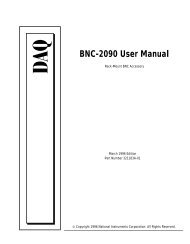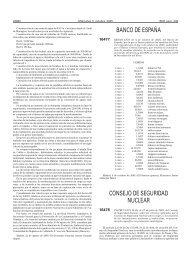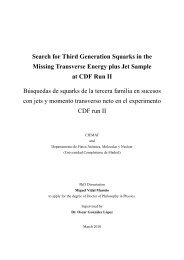EntrEntr evista/evista/ InterInter viewview
EntrEntr evista/evista/ InterInter viewview
EntrEntr evista/evista/ InterInter viewview
Create successful ePaper yourself
Turn your PDF publications into a flip-book with our unique Google optimized e-Paper software.
Government. The fact that no resolution has been<br />
reached during 1999 has caused the existing<br />
uncertainty to negatively affect the valuation of our<br />
companies.<br />
The future of the electricity industry<br />
A great deal has been achieved as regards the<br />
process of liberalising the sector. Facing the<br />
challenges that have emerged, the electricity<br />
industry has managed to successfully meet the<br />
demands of this more competitive framework, has<br />
taken advantage of the market opportunities and has<br />
consolidated its foundations with a view to continue<br />
growing and creating value in international business<br />
and diversification.<br />
Nevertheless, much remains to be done. Three<br />
aspects may be singled out as regards regulation.<br />
The first, as has been pointed out, is the need to<br />
design a new electricity tariffing structure in keeping<br />
with criteria of correct assignment of costs. The<br />
second is the regulatory development of the<br />
Hydrocarbon Act, aimed at really liberalising the<br />
supply of a material as important for the electricity<br />
sector as natural gas, and at ensuring that the degree<br />
of opening of the market and actual competition be<br />
similar for both energy sub-sectors. Finally, mention<br />
should be made of the need for the Transmission and<br />
Distribution Regulation to be approved, in order to<br />
clarify aspects which are particularly relevant to the<br />
life of the companies, such as for example definition<br />
of the levels of competence of the Autonomous<br />
Communities and the Central Government. Other<br />
aspects relating to the quality of the service also<br />
require clarification.<br />
CONCLUSIONS<br />
We may, therefore, state that since the design and<br />
start-up of the new framework for liberalisation and<br />
competition in the electricity industry were initiated,<br />
the electricity companies have demonstrated the<br />
technical capacity of their installations, which is<br />
undoubtedly comparable to the best technologies<br />
existing in the western world. They have also made<br />
important economic sacrifices. The different<br />
regulatory modifications that have been made, in<br />
excess of the requirements of Law 54/97 and hardly<br />
two years after its entry into force, are a<br />
demonstration of the political intent to promote<br />
participation on the market and thus contribute to<br />
improving the competitiveness of the Spanish<br />
economy. Logically, the risk involved on a<br />
competitive market must be assumed by the<br />
companies and by the investors; however, the risk<br />
implied by regulatory uncertainty leads to<br />
undesirable expectations regarding our companies<br />
on the securities markets.<br />
One way or another, and in spite of the new<br />
demands, the new framework offers clear<br />
opportunities for growth and for the creation of value.<br />
The new liberalised and competitive environment<br />
leaves a greater margin for the electricity companies<br />
to freely adopt decisions and use their technical,<br />
economic and human resources efficiently.<br />
In the near future we shall be witnesses to the<br />
completion of the process of transition to a<br />
competitive framework in which we are currently<br />
immersed, and to new structural changes in the<br />
electricity industry. These will come about firstly due<br />
to the need to achieve a true single electricity<br />
market, as indicated in the Community Directive,<br />
secondly as a result of market globalisation and<br />
finally due to the diversification in electricity supply<br />
to markets other than the domestic. In relation to the<br />
above, consideration should be given also to the<br />
new opportunities for business and diversification<br />
through non-electrical investments, taking advantage<br />
of the synergies and capacities deriving from the<br />
specialist nature of the electricity business.<br />
deberían tomarse en consideración a<br />
la hora de elaborar dicha metodología.<br />
Estamos convencidos de la utilidad<br />
de este esfuerzo y de que, a lo<br />
largo del año 2000, podremos disponer<br />
de una nueva estructura de tarifas<br />
de acceso acorde con la realidad<br />
actual de nuestro sistema eléctrico.<br />
Por último, en relación con los<br />
Costes de Transición a la Competencia,<br />
señalar que su método de<br />
cálculo ha sido objeto de estudio y<br />
análisis por la Comisión Europea y<br />
que la resolución definitiva que<br />
adopten las autoridades de la Unión<br />
Europea se encuentra actualmente<br />
en su fase final. Esperamos, tal como<br />
ha indicado recientemente el<br />
Comisario Sr. Monti, que se resuelva<br />
cuanto antes y en los términos propuestos<br />
por el Gobierno español. El<br />
hecho de que durante el año 1999<br />
no se haya alcanzado una resolución<br />
ha provocado que la incertidumbre<br />
existente haya afectado a la<br />
valoración de nuestras empresas de<br />
un modo negativo.<br />
Futuro del sector eléctrico<br />
Muchos son los logros que se han<br />
conseguido en el proceso de liberalización<br />
del sector. Haciendo frente<br />
a los retos que se han venido planteando,<br />
la industria eléctrica ha<br />
conseguido superar con éxito las<br />
exigencias de este marco más competitivo,<br />
ha aprovechado las oportunidades<br />
de los mercados y se han<br />
consolidado sus fundamentos para<br />
seguir creciendo y creando valor en<br />
los negocios internacionales y de diversificación.<br />
Pero queda, sin embargo, mucho<br />
por hacer. En materia normativa,<br />
tres son los aspectos a destacar. El<br />
primero de ellos, como ya ha dicho,<br />
es la necesidad de establecer el diseño<br />
de una nueva estructura de tarifas<br />
eléctricas que respondan a<br />
unos criterios de asignación correcta<br />
de costes. El segundo, el desarrollo<br />
regulatorio de la Ley de<br />
Hidrocarburos, dirigido a liberalizar<br />
realmente el suministro de una materia<br />
tan importante para el sector<br />
eléctrico como es el gas natural y a<br />
que el grado de apertura y competencia<br />
real que se alcance sea similar<br />
en ambos subsectores energéticos.<br />
Por último, cabe mencionar la<br />
necesidad de que se apruebe el<br />
Reglamento de Transporte y<br />
Distribución, con el fin de clarificar<br />
aspectos tan relevantes para la vida<br />
de las empresas como, por ejemplo<br />
la definición de competencia entre<br />
las Comunidades Autónomas y el<br />
Gobierno Central así como otros aspectos<br />
relacionados con la calidad<br />
del servicio.<br />
Conclusiones<br />
Podemos pues afirmar que, desde<br />
que se inició el diseño y puesta en<br />
marcha del nuevo marco de liberalización<br />
y competencia del sector<br />
eléctrico, las empresas eléctricas<br />
han demostrado la capacidad técnica<br />
de sus instalaciones, comparable<br />
sin lugar a dudas con las mejores<br />
tecnologías existentes en el mundo<br />
occidental, y, además, han asumido<br />
un importante sacrificio económico.<br />
Las sucesivas modificaciones regulatorias<br />
que se han ido introduciendo<br />
más allá de lo establecido en la<br />
Ley 54/97 del Sector Eléctrico, a escasamente<br />
dos años desde su entrada<br />
en vigor, responden a la voluntad<br />
política de animar la<br />
participación en el mercado contribuyendo<br />
a mejorar la competitividad<br />
de la economía española.<br />
Como es lógico, el riesgo del mercado<br />
en su régimen de competencia<br />
debe ser asumido por las empresas<br />
y por los propios inversores; sin embargo,<br />
el riesgo que introduce la incertidumbre<br />
regulatoria provoca expectativas<br />
no deseadas de nuestras<br />
empresas en los mercados de valores.<br />
En cualquier caso, y a pesar de las<br />
nuevas exigencias, el nuevo marco<br />
ofrece claras oportunidades de crecimiento<br />
y de creación de valor. El<br />
nuevo entorno liberalizado y competitivo<br />
deja un margen mayor a las<br />
empresas eléctricas para que adopten<br />
libremente decisiones y utilicen<br />
eficientemente sus recursos técnicos,<br />
económicos y humanos.<br />
En un futuro próximo asistiremos<br />
a la finalización del proceso de<br />
transición a la competencia, en que<br />
ahora nos encontramos, y a nuevos<br />
cambios estructurales en la industria<br />
eléctrica obligados, en primer lugar,<br />
por la necesidad de lograr un verdadero<br />
mercado interior de la electricidad,<br />
tal como indica la Directiva<br />
Comunitaria; en segundo lugar, por<br />
la globalización de los mercados; y,<br />
por último, por la diversificación en<br />
el suministro de energía eléctrica a<br />
otros mercados distintos de los nacionales.<br />
Todo ello teniendo en<br />
cuenta, además, las nuevas oportunidades<br />
de negocio y de diversificación<br />
mediante inversiones no eléctricas<br />
aprovechando las sinergias y<br />
capacidades derivadas de la propia<br />
especialización del negocio eléctrico.<br />
A b r i l 2 0 0 0<br />
R e v i s t a S N E
















